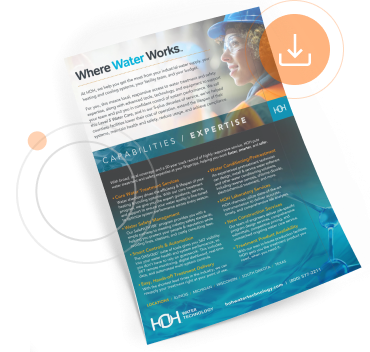Stay Compliant With ASHRAE 188
Keep Your Facility Safe From Waterborne Diseases
At HOH, we're committed to promoting healthy and productive workspaces. SafePath188, our water safety management program, is a simple, smart way to meet industry standards for safe water and ensure full compliance with ASHRAE Standard 188.
Starting with a water safety management plan, SafePath188 lets you:
- Effectively manage health risk and liability
- Eliminate compliance headaches
- Simplify planning and documentation
- Implement turnkey testing and treatment
- Get lightning-fast emergency response
Consider Your Building's Risk for Legionella
The Legionella bacteria exist naturally in freshwater sources such as lakes and streams, but once it enters a closed water system, it can grow and pose a serious threat to the people in your building.
Cooling towers, expansion tanks, water filters, showerheads and hoses, pipes, valves, and fittings are common locations for Legionella growth.
Understand Waterborne Pathogen Control
According to the CDC, reported cases of Legionnaires’ disease have grown by more than five times since 2000. And while Legionella makes the headlines, there are other dangerous pathogens that can cause problems in your building's water systems.
Pathogen control is important for compliance with industry standards, maintaining your organization's reputation, and avoiding possible litigation. (The average cost of a Legionella claim is $11MM). Most important though, is the prevention of an outbreak that could cause severe illness or even the loss of human life.
Having a water safety management plan and the support of a trusted water treatment partner is critical to protect your facility and the people inside. We can help.
Need to learn more? Subscribe to our blog and get insights from our water safety engineers on how to combat waterborne pathogens in your building.
What causes Legionella to grow?
There are many variables that can cause it to grow inside of pipes and equipment, including fluctuations in pH levels, water temperature, stagnant zones, and insufficient levels of disinfectant.
External factors such as water main breaks, construction in or around your building, or changes in the municipal water supply can cause Legionella growth as well.
And where there's Legionella, there could be other waterborne pathogens present such as:
any building can be at risk for Legionella, but certain facilities need to be especially vigilant.
These types of facilities typically house more vulnerable populations, many with underlying conditions and compromised immune systems. Patients and residents in these facilities are at much higher risk when exposed to Legionella.
The presence of the Legionella bacteria can cause Legionnaires' disease, a severe form of pneumonia and Pontiac fever, a milder illness resembling the flu. It's important to have a clear understanding of the risks of Legionella, what causes it to grow, and how to prevent it.
Prevent Legionella and waterborne pathogens
The prevention of waterborne pathogens, including Legionella, requires a water safety management plan for your facility, and a team in place to get the work done and keep the plan on track.
While all water safety plans should be customized to the needs and challenges of individual facilities, most plans include these eight essential steps:

Your facility team may be able to handle some of these tasks, but it's a good idea to work with a water treatment partner with extensive experience preventing, mitigating, and controlling waterborne pathogens.
A water treatment expert can help you avoid commonly-made mistakes, uncover areas of your facility that need closer monitoring, and keep you compliant with industry standards for water safety.
Get Support For All Your Water Systems


